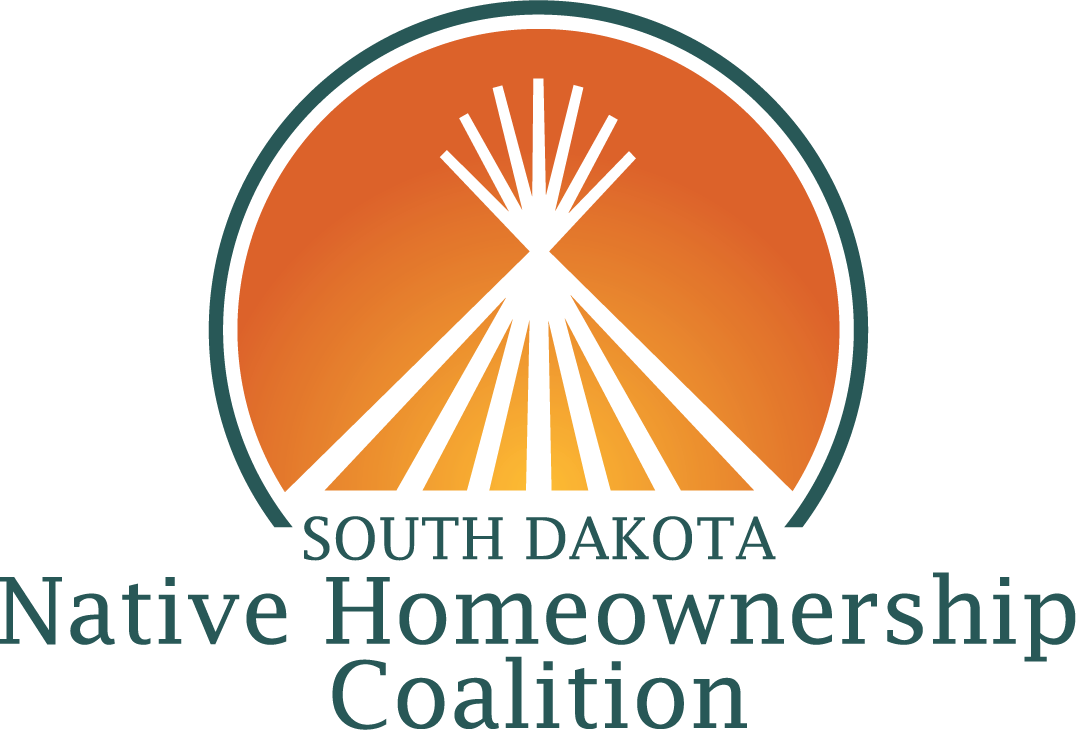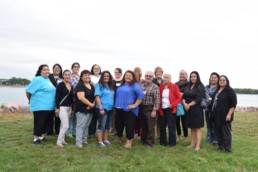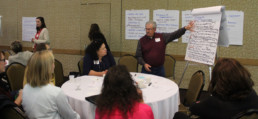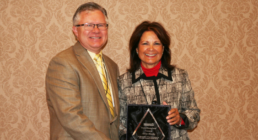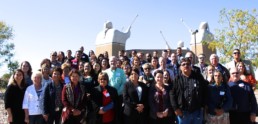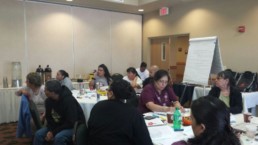Coalition conducts successful Post Purchase Certification Training in Pierre!
On September 22, 2016, sixteen homebuyer practitioners from around the state became certified to teach post-purchase homebuyer education in their communities. These practitioners completed an intensive 4-day training on “Post Purchase Education Methods” sponsored by the Coalition in coordination with NeighborWorks America and Neighborworks Dakota Home Resources.
The training focused on important information for homebuyers, including:
- Budgeting and Finances
- Maintenance
- Community Issues
It also included a number of hands-on maintenance activities for participants. Participants especially liked the hands-on activities (including fixing a window screen and drywall) and the chance to get to know fellow practitioners working to assist Native families attain homeownership.
Coalition Members Visit Cheyenne River to Learn About Homeownership Efforts
On June 29, 2016, over fifty members of the SD Native Homeownership Coalition visited the Cheyenne River Reservation, the Coalition’s third annual visit to a tribal community. In 2014, Coalition members visited the Pine Ridge Reservation and in 2015, members visited the Sisseton Wahpeton Oyate. Coalition partners on the Cheyenne River tour/convening represented TDHEs, Native and non-Native nonprofit organizations, Native and non-Native CDFIs, federal partners (including USDA, HUD, and the VA), and state partners (including the SD Housing Development Authority and the Department of Tribal Relations).
The day started in Mobridge, with an opening prayer, welcome remarks by Sharon Vogel, the Executive Director of the Cheyenne River Housing Authority, introductions, and milestone updates from the Coalition’s different committees. From Mobridge, Coalition members traveled by bus to Eagle Butte, a two-hour trip. On the way, partners saw a diverse mixture of homeownership homes that ranged from CRHA Mutual Help homes to mortgage loan financing (VA, USDA, HUD-ONAP 184), and visited the White Horse community. The bus trip provided the opportunity for Coalition members to visit with one another, see the remote and isolated nature of Cheyenne River communities, and gain an understanding of the pros and cons of these locations.
In Eagle Butte, Coalition partners visited the impressive hospital staff quarters neighborhood, and saw the 160 acre Badger Park site that the Housing Authority is developing. With infrastructure in place, including utility service lines, curbs, gutters, and road, the Housing Authority is scheduled to start having homes go up within the year. Coalition members were impressed by the site, and are looking forward to a return visit to see completed homes.
After visiting the Badger Park site, Coalition members convened for lunch, with remarks by Tribal Chairman Harold Frazier and Bush Fellow Eileen Briggs. Lunch included a birthday cake to celebrate the third birthday of the Coalition – the group’s first convening was held on June 27, 2016 in Pierre! Following lunch, Coalition members convened at the Oglala Lakota College/Cheyenne River College Center for a series of afternoon discussions. After a welcome by Dave West, Jr., the Center Director, Taffy Lafferty and Sharon Vogel shared the preliminary results of their organizations’ housing needs assessments, which are being facilitated by the Coalition and supported by the SD Housing Development Authority. Coalition members then met with three homeowners to learn about some of the challenges they encountered, and then Sharon reviewed the key steps to homeownership.
Overall, it was a packed day, and participants reported that they were very impressed by the work of the Cheyenne River Housing Authority, and appreciated “covering the reservation where the action is.”
Crow Creek Tribal Member Realizes Homeownership Dream
On January 5, 2016, Airryn Big Eagle (Crow Creek Sioux) purchased a home after saving for two years through Hunkpati Investments’ matched savings program. As a Native community development financial institution and a member of the South Dakota Native Homeownership Coalition, Hunkpati Investments’ matched savings program, also known as an Individual Development Account (IDA) program, enables tribal members to build assets through homeownership, secondary education, or business development. By participating in this program Airryn Big Eagle was able to receive $8.00 for every dollar she deposited into a special savings account.
Airryn says, “I always dreamed of owning my very own vehicle, my own business, and having a home to call my own. As a young Native American woman, I never thought that I would have any of those things. I believed that all of the above was nothing but a dream, and that’s all it would ever be.”
Airryn began working with Hunkpati Investments in 2012 to build her personal financial skills, improve her credit, and start her own business. She enrolled in the matched savings program in July of 2013 and discovered homeownership might be a possibility for her. She says, “I could not get the idea of becoming a homeowner out of my head. It had always been a dream of mine.”
Airryn took the homeownership preparedness course that Hunkpati offered, and learned about all of the expenses and steps she would need to take in order to make her dream come true. She looked into several financing options and ended up choosing the USDA Rural Development loan. She comments on the moment she found out she was approved for her loan, “I cried like a baby. I was worthy of a home loan!”
After a long commitment to saving and much research, Airryn was able to use the funds from her Individual Development Account as a down payment for a home within her budget. She went through the necessary steps to close the loan, and is now a proud homeowner.
2015 Annual Housing Conference a Success!
Much shared and learned at the Coalition’s events during conference.
The South Dakota Native Homeownership Coalition had another successful year at the South Dakota Housing Development Authority (SDHDA) Annual Housing Conference in Pierre. Highlights of the conference included:
- A terrific planning session
- Five workshops through our Native Homeownership Track
- Special sessions on impact tracking and Sisseton Wahpeton Oyate’s new risk mitigation pool
It was also wonderful to see one of the Coalition’s founders, Elsie Meeks, honored by the SDHDA through the “Friend of Housing Award”! Coalition members are excited about what we can accomplish as we move forward together.
Summary of Native Conference Events
Strategic Planning Check-in
Over seventy Coalition partners attended our one-day “Strategic Planning Check-in” pre-conference session on Monday, October 26th. Partners spent the day discussing the benefits of the Coalition, revisiting the Coalition’s original strategic plan, looking at committee accomplishments and future milestones, learning about baseline data collection efforts, and exploring different key issues, including income-generation strategies to promote the Coalition’s sustainability, how to take communication efforts to the next level, long-term impacts the Coalition is working to achieve, and organizational structure options.
Risk Mitigation Pool – Memorandum of Understanding Signing
On Monday, October 26th, J.C. Crawford, Executive Director of the Sisseton Wahpeton Oyate Housing Authority and Bruce Jones, Interim State Director of USDA/Rural Development signed a Memorandum of Understanding creating a “risk mitigation pool” to offset the risk of foreclosure for loans originated on trust land. Through this initiative, the Sisseton Wahpeton tribe will purchase any loans at risk of foreclosure and re-sell the home to another qualified tribal member. Coalition members interested in learning more about the risk mitigation pool participated in a Coalition discussion Tuesday morning, where the different partners explained the new initiative and its creation in more detail.
Impact Tracking Working Session
On Tuesday, October 27th, homeownership practitioners participated in an impact tracking session, discussing impacts that we will be tracking to document the impact of the Coalition, and providing feedback on a data collection tool developed by Sweet Grass Consulting.
Native Homeownership Track
Coalition members also participated in five workshops through the Native Homeownership Track, focusing on a conversation with funders, navigating the leasehold process, understanding housing needs assessments, working with contractors to increase housing stock on reservations, and leveraging “lump sum” payments to increase Native American homeownership. These workshops were designed by our Coalition committees, and led, in large part, by Coalition members.
Post-Conference Debriefing Session
Coalition members gathered at the conclusion of the conference to reflect on the Coalition’s events over the week and look ahead to what lies on the horizon for 2016. Members committed to completing leasehold and homebuilding process flowcharts currently in progress, reaching out to tribal leaders, conducting an inspector certification training, and sharing the work of the Coalition on a regional and national level.
“Friend of Housing Award” Goes to Elsie Meeks
First-Ever Native American Recipient of Award
South Dakota Housing Development Authority (SDHDA) awarded Elsie Meeks with the “Friend of Housing” award during SDHDA’s 25th Annual Housing Conference held earlier this week in Pierre. Ms. Meeks was honored for her dedication and contribution to affordable housing in South Dakota. She has used innovation and determination to ensure that all South Dakotans have access to safe and affordable housing.
“Elsie was chosen as the recipient of the Friend of Housing Award by being a true leader and by not being afraid to fight for what is right,” said Mark Lauseng, Executive Director of SDHDA. “She serves as a valuable resource to our state on a variety of housing related issues and is always up for a challenge.”
Meeks has had a career of “firsts” and a long string of innovative successes promoting affordable housing. She helped South Dakota make national history through the first ever low-income housing tax credit project to be financed on tribal land and she was the first Native American to serve on the U.S. Commission on Civil Rights. In addition, Meeks also brought together key representatives from the South Dakota Housing Development Authority, Governor’s Office, Rural Development and the Department of Tribal Relations to form the South Dakota Native Homeownership Coalition to work together to ensure that housing programs effectively reach Native communities and increase Native homeownership rates.
Ms. Meeks’ career includes over 20 years of experience working to promote economic and community development first as the president/CEO of First Nations Oweesta Corporation and then as the state director of USDA Rural Development.
Even in her retirement, Ms. Meeks remains committed and dedicated to promoting affordable housing. She serves as a member of the Board of Directors of the Federal Home Loan Bank of Des Moines, executive committee member of the South Dakota Native Homeownership Coalition, chairperson of the Board of Directors of Lakota Funds and a member of the Board of Directors of the Northwest Area Foundation.
The Friend of Housing Award was started 16 years ago to recognize individuals and/or companies who are instrumental in providing affordable housing in South Dakota. Annually, SDHDA accepts nominations for the award and announces the recipient at their annual housing conference.
Loan Office Serves Native Americans
As printed in the Argus Leader…
Juel Burnette left Wells Fargo & Co. last year after a 23-year career with a specific focus as the Sioux Falls branch manager of 1st Tribal Lending.
“We’re a mortgage company that’s focusing on providing home loans and homeownership opportunities to Native Americans on and off the reservation nationwide,” Burnette said.
Burnette wasn’t alone. The other three loan officers are former Wells Fargo employees, all of whom have years of experience working together in lending to Native Americans.
The office of 1st Tribal Lending, a division of Mid America Mortgage, is at 1300 W. 57th St.
“The beauty of this was our clientele came with us I think due to experience, so we didn’t have a big loss there,” said loan officer Eric Sprenkle. “The tribes, they reached out to us and wanted to continue to do business with us. They have a trust in us … because of that experience we have.”
The Sioux Falls branch of 1st Tribal Lending is the easternmost branch for the lender, which specializes in using the U.S. Department of Housing and Urban Development Section 184 Indian Home Loan Guarantee Program. Other branches are in California, Arizona, Oregon, Washington and Oklahoma.
The program was created in 1992 as a way to remedy the lack of home loans to Native Americans.
“There weren’t a lot of lenders out there that were participating in bringing mortgage capital to Indian Country, specifically on the reservation,” Burnette said, “so this was the government’s way of trying to entice lenders to open up their doors.”
The program enables lenders to give loans for land held in tribal trusts and allows lenders to give loans not just to tribal members but also to tribes and tribal housing authorities.
“It’s unique in that way that it’s the only program that allows a non-individual to be the borrower,” Burnette said. “We’ve done several projects for tribes and tribal housing authorities, so they can provide homes to their tribal membership also. They typically do that to help those families that aren’t quite ready today or if they just want to build on their current rental stock they have or add to it.”
And Native Americans don’t need to live on tribal lands to take advantage of the program.
“It’s open up to the entire state of South Dakota, and there’s some misconception about that because a lot of lenders and tribal members think you have to be on the reservation in order use the program, and that’s not the case,” Sprenkle said. “If you’re a Native American here in Sioux Falls, you can utilize the program.
Sisseton-Wahpeton Oyate Tribe Showcases Successful Models to Increase Native American Homeownership
Approximately 100 federal and state agencies, tribal entities, policy makers, lenders, tribal enterprises, and nonprofit organizations gathered at Sisseton Wahpeton College to discuss homeownership as a solution to the long-standing housing shortages that Indian reservations face. While homeownership in mainstream America has become a greater challenge following the mortgage crisis in 2008, it has always been perceived as an elusive dream for those that reside on Indian reservations.
During her video address in the welcoming remarks of the event, Senator Heidi Hietkamp acknowledged these challenges and commended the Coalition for its work.
Although achieving homeownership on a reservation is a complex puzzle, it is not impossible. Groups like the South Dakota Native Homeownership Coalition that facilitated the Sisseton convening are working to put the pieces together. The meeting focused on the successful homeownership efforts of T Yamni Sisseton Wahpeton Oyate and provided models for other reservation communities to follow.
T Yamni regularly works with over 20 partner organizations to help make homeownership possible for tribal members. The organization is considered a leader in the Native homeownership field, and has help many tribal members navigate the path toward homeownership. As part of the convening, attendees toured the recently completed Long Hollow subdivision that is comprised of approximately 10 single-family homes.
Convening attendees engaged in dynamic and solution-oriented dialogue on potential ways to remove barriers to homeownership. Solutions discussed included:
- Risk Mitigation Partnership: To encourage more lending and investment from financial institutions, a pool of funds would be created by the tribe. Funds would be used to purchase a home in the event that it should go into foreclosure. This would essentially be a loan guarantee program established by the tribe, and it would also ensure that homes on tribal land stay within tribal membership.
- Land Bank Inventory: To streamline the lease process, the Sisseton Wahpeton Oyate is developing a plan to inventory all trust land on the reservation. This would provide them with the ability to easily identify areas or parcels that would be available as home sites, rather than going through such a long and arduous process for each individual homeowner.
Coalition to Launch Native Housing Needs Studies Project
With support from the South Dakota Governor’s Office and the South Dakota Housing Development Authority, the South Dakota Native Homeownership Coalition will be facilitating housing needs studies (Studies) in two small tribal communities in South Dakota.
These Studies will be designed to aide community members and decision makers in developing a meaningful sense of the housing market in their community and play an important role in effective planning for future housing efforts. The study for each community will include the following data elements: existing housing stock, housing issues, homeownership information, information on housing providers and programs, potential barriers to homeownership, demographics, economics, and recommendations.
In facilitating these housing needs studies, the Coalition will identify two tribal communities to be assessed through an application process, and select an experienced firm to carry out the assessments through a competitive proposal process. Work to conduct these Studies will start by October 1, 2015, and Studies will be completed by March 31, 2016.
More Information for Tribal Communities
Under the program guidelines, eligible tribal communities must have a population of 10,000 or less. The size of the community/reservation will determine whether one specific community or the broader reservation will be assessed. If selected, the tribal community must designate at least one staff member to dedicate sufficient time and attention to the assessment.
Each selected community will be required to cover 50% of the cost of each study, up to $10,000. There are no restrictions on the source of funds; however, funds must be provided in cash by October 1, 2015.
To apply, interested communities should submit completed applications according to the guidelines stated in the application package by September 1, 2015.
More Information for Tribal Communities
Under the program guidelines, eligible tribal communities must have a population of 10,000 or less. The size of the community/reservation will determine whether one specific community or the broader reservation will be assessed. If selected, the tribal community must designate at least one staff member to dedicate sufficient time and attention to the assessment.
Each selected community will be required to cover 50% of the cost of each study, up to $10,000. There are no restrictions on the source of funds; however, funds must be provided in cash by October 1, 2015.
To apply, interested communities should submit completed applications according to the guidelines stated in the application package by September 1, 2015.
Questions
The Coalition will be accepting questions regarding the application for assessment and the Request for Proposal from August 1 – 15, 2015. Questions will be submitted and answered through an open and transparent platform on our website.
Please submit questions through the Comments platform below, and be sure to state whether your question is for the application or the Request for Proposal. All questions will be fielded and answered through the Comments platform within 48 hours.
Coalition Hosts Meetings with Contractors to Foster Increased Building
On March 10 and June 3, 2015 the South Dakota Native Homeownership Coalition met with contractors on the Pine Ridge Reservation to explore how to support contractors’ efforts to build more homes. Suggested tools and strategies from these meetings included:
- providing sample construction contracts and agreements
- developing model building codes
- looking into conducting an inspector certification training
- mapping out the construction process for potential homebuyers
At the June 3 meeting, Juel Burnette of 1st Tribal Lending also shared information on HUD/ONAP contractor “validation” requirements.
Twenty-five Practitioners Become Certified as Homebuyer Education Instructors
On May 27 – 29, 2015, twenty-five homeownership practitioners attended a three-day homebuyer education instructor certification training in Pierre, South Dakota. The in-depth training focused on homebuyer education for Native communities. Through the session, participants became certified to teach Pathways Home homebuyer education classes in their communities.
The training was sponsored by the South Dakota Native Homeownership Coalition, in partnership with GROW South Dakota and its RCDI Initiative. Additional support was provided by 1st Tribal Lending, Wells Fargo, and Dacotah Bank. The training was facilitated by the National American Indian Housing Council in partnership with Seven Sisters Community Development Group.
